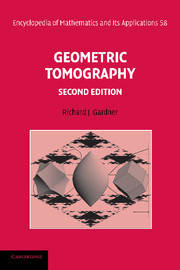Book contents
- Frontmatter
- Contents
- Preface to the second edition
- Preface
- 0 Background material
- 1 Parallel X-rays of planar convex bodies
- 2 Parallel X-rays in n dimensions
- 3 Projections and projection functions
- 4 Projection bodies and volume inequalities
- 5 Point X-rays
- 6 Chord functions and equichordal problems
- 7 Sections, section functions, and point X-rays
- 8 Intersection bodies and volume inequalities
- 9 Estimates from projection and section functions
- Appendixes
- References
- Notation
- Author index
- Subject index
9 - Estimates from projection and section functions
Published online by Cambridge University Press: 05 June 2013
- Frontmatter
- Contents
- Preface to the second edition
- Preface
- 0 Background material
- 1 Parallel X-rays of planar convex bodies
- 2 Parallel X-rays in n dimensions
- 3 Projections and projection functions
- 4 Projection bodies and volume inequalities
- 5 Point X-rays
- 6 Chord functions and equichordal problems
- 7 Sections, section functions, and point X-rays
- 8 Intersection bodies and volume inequalities
- 9 Estimates from projection and section functions
- Appendixes
- References
- Notation
- Author index
- Subject index
Summary
In this chapter we collect results permitting the estimation of an object from projection functions, or section functions such as point X-rays. The estimates are of quantities such as volume and surface area. The topic presents an excellent opportunity to make acquaintance with centroid bodies and some fascinating and important affine isoperimetric inequalities.
Centroid bodies are introduced in the first section. A centroid body is a centered zonoid whose boundary depends on the centroids of “halves” of a compact set. The volume of a centroid body is given by a formula involving the average volumes of simplices with one vertex at the origin and the others in the associated compact set. This and Steiner symmetrization are the principal ingredients in the first affine isoperimetric inequality of Section 9.2, the Busemann random simplex inequality, Theorem 9.2.6. The Busemann–Petty centroid inequality, Corollary 9.2.7, relating volumes of a convex body and its centroid body, follows easily. This in turn leads to the Petty projection inequality, Theorem 9.2.9, an upper bound for the volume of a convex body in terms of that of the polar body of its projection body. For a centered convex body, the Blaschke–Santaló inequality, Theorem 9.2.11, provides a similar upper bound in terms of its polar body, but requires different techniques for its proof.
- Type
- Chapter
- Information
- Geometric Tomography , pp. 350 - 390Publisher: Cambridge University PressPrint publication year: 2006



